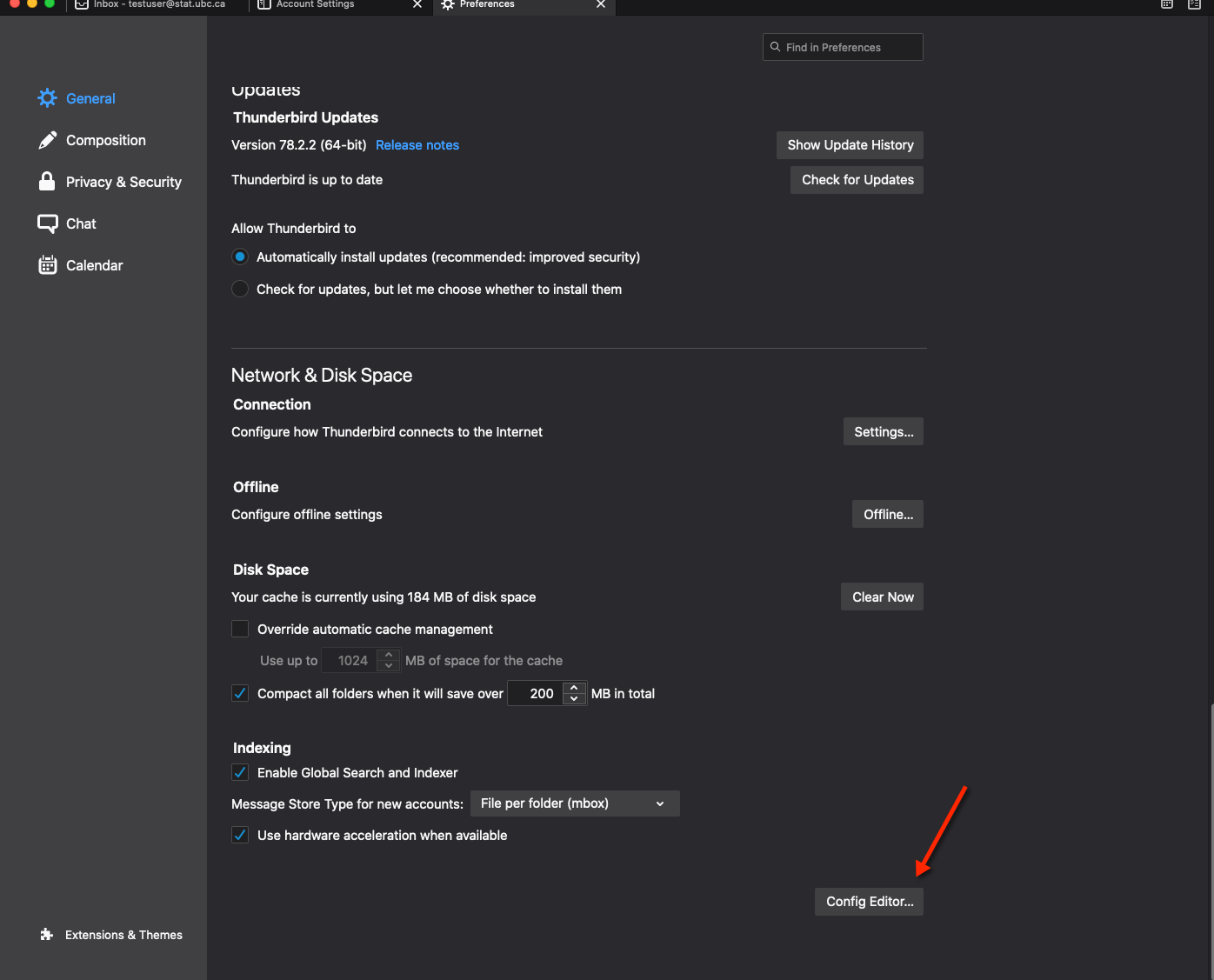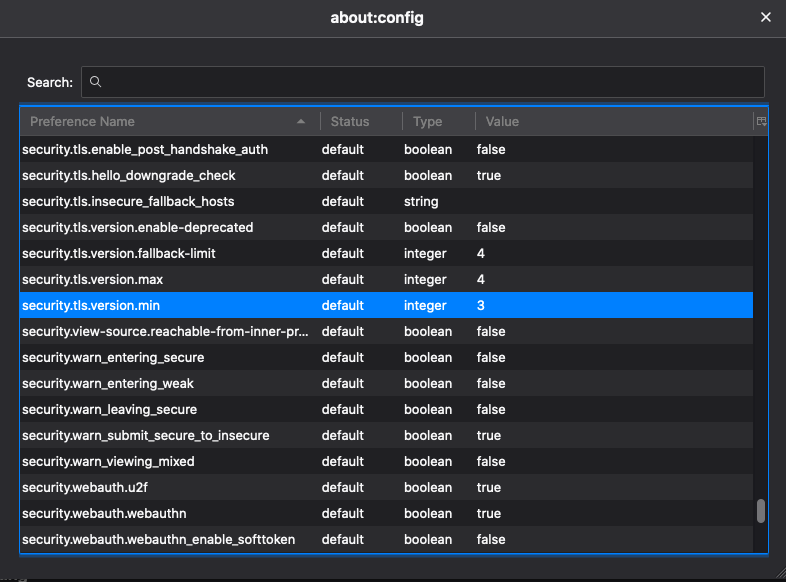You can setup Outlook/Apple/Thunderbird mail reader to read StatNet email. Remember to disable "Automatic manage connections" on the email client.
Here are the parameters you need to know:
Incoming mail server: imaps.stat.ubc.ca
Protocol: IMAP
Port:
If using STARTTLS: 143
If using SSL: 993
Mail Folder Prefix: (leave empty)
Outgoing mail server: mailhost.stat.ubc.ca
Protocol: SMTP
Port: one of either Ports: SMTP/STARTTLS: port 587
SMTP/SSL: port 465
If there is a choice of authentication methods, LOGIN or PLAIN will work.
UBC OneDrive info/howto:
https://it.ubc.ca/services/web-servers-storage/microsoft-onedrive
Basically OneDrive is similar to our ownCloud/Nextcloud or Dropbox services.
You will have 2 ways to access it:
a) Cloud access
Faculty and staff who meet the service requirements will be able to access the tools at https://portal.office.com by signing in with their alias.
Login: firstname.lastname [at] ubc.ca
Password: your CWL password
and going through the UBC multi-factor authentication process.
From there, they can use the web-based versions or download the OneDrive software to install it onto your desktop/laptop locally.
b) Direct access as a local drive on your desktop/laptop
You will need to install an OneDrive software, download after you login "Cloud access", onto your device so it can sync data with the OneDrive on the Cloud.
Please click here to view in pdf
Overview
The UBC Faculty & Staff Email (FASmail) service is an enterprise email service for eligible staff, faculty and student employees of the University of British Columbia.
Documentation and References
UBC Faculty & Staff Email (FASmail)
Getting Started
*Send a request directly to UBC IT by fill in...
The "FASmail Service Request Web Form" (*Ignore "For Departmental Administrators only")
and ask for FASmail mail box with FASmail alias, "firstname.lastname(at)ubc.ca".
WebForm:
https://web.it.ubc.ca/forms/fasmail/
*Note: Make sure to supply these options...
...
[Requestor Type]
Service* [ FASmail User Mailbox ]
Request Type* (x) Add
[Technical Details]
- User's Email Alias*
(x) firstname.lastname(at)ubc.ca email alias
...
If you want to forward FASmail to your StatNet email, ask UBC IT do it for you as it's much simpler.
After you have your FASmail setup with an alias firstname.lastname@ubc.ca, notify Assistant to Head (headsec at stat.ubc.ca), so she can add your new alias to UBC Directory.
You can check it here see if it's ready entered or not.
https://directory.ubc.ca/index.cfm
Thunderbird 78 has stopped out of date use of SSLv3 and TLSv1. Here is how to fix:
- Go to Thunderbird -> Preferences -> General (for Windows users: From Home tab, click on the menu button on the top-right corner, select Options -> General)
- At the bottom of the page, click on buton Config Editor…

- Click to confirm "I accept the risk!"
- Scroll down to the line: security.tls.version.min and change value from 3 to 1

- Restart Thunderbird
Incoming Mail Server:
IMAP Mail Sever:
- Server Name: imap.stat.ubc.ca
- Port: 143
- Connection security: STARTTLS
- Authentication method: Normal password
- Or: Port 993 use SSL
Outgoing Mail Server:
- Server name: smtp.stat.ubc.ca
- Port: 587
- Authentication method: Normal password
- Connection Security STATTLS
1) StatNet servers:
Number crunching servers: Access via "ssh" remote login.
Linux servers : Dell R900, 16 CPUs, 16-32Gb RAM. Name after Bugs : Bee and Spider are standalone number crunching.
Virtual Linux servers: 2 CPUs, 2Gb RAM: Gosset1
Cloud Computing: contact us for more detail.
Can only access via SSH.
Software: R, C, C++, Fortran, Matlab 2009a , Java and Stata (Stata only on Gosset1 ).
MacPro servers : 8 CPUs, 8-16Gb RAM. Name after Mountain: Cypress, Grouse, Baker, Seymour: Can access via SSH and its console which located in Research lab lsk303a. You need Secure Card access to enter.
Software: OS Mac OS X Leopard, Same as Linux except R = R64 (64-bit) and Matlab 2009a
SUN Solaris 10 Unix servers: Access via "ssh" remote login.
Be.stat.ubc.ca for pine, mutt, elm and general file management only
Unixlab for IT admin only
2) Ugrad Math/Stat Computer labs
Notes: You can ONLY acess Windows server within StatNet.
Download Microsoft Remote Desktop software for your OS
Mac: Remote Desktop Connection Client 2.1
Linux: Rdesktop
Windows: Come with all OS
LSK 121: SUN Unix Solaris 10 servers
Server names: Unixlab and Statlab
Software: R, and most opensource packages
LSK 121: Windows 2003 terminal servers
Server names: windows.stat.ubc.ca
Software: Matlab, Maple, MS-Office, R, Octave, OpenBUGS/WinBUGS, TeX/LaTeX, XPP
ESB 1042 and ESB 1046: Mac OSX Lion 10.7.5 workstations
Software: Matlab, Maple, R, OpenOffice and some opensource packages
LSK 310: Windows 7 workstations
Software: Matlab, Maple, MS Office, Lindo/Lingo , R, Octave, OpenBUGS/WinBUGS, TeX/LaTeX, XPP
To borrow laptop and/or projector, you need to go to the general office to sign-in. When you return them, you need to sign-out in the general office.
The laptop OSs: Microsoft Windows 7 and Mac OS X
Both laptop and projector can be booked using MRBS booking app.
Ask the general office for help if you want to send fax. When you send fax, the document should face down.
This a rather complex question that really can't be fully addressed by a FAQ, but here are some questions that you can ask yourself that can provide a hint of what kind of PC which would be suitable for you:
- What kind of computer (i.e. desktop vs. laptop vs. other) do you want? In general, the type of PC you should get should mainly depend on the type of software you run.
- Thin clients (X terminals)
- Good for those people that want nothing to do with devices. It just work or doesn't. No configuration and the hosts that it connects to are managed by somebody else (us!).
- Not good for those that want their own PCs, run their own software or have large resource requirements.
- Laptops
- Is weight and portability the most important criteria?
- Feather Light (less than 3.2 pounds)
- advantages: lightest and most portable
- disadvantages: expensive, small screen, performance lags behind others, may not have internal CD/DVD drive.
- Medium size (4.5 to 7.0 pounds)
- compromise between Feather Light and Large.
- Large (more than 7 pounds)
- largest screen, best performance, usually has built-in CD/DVD reader, most economical with same features.
- disadvantage: bulky.
- Feather Light (less than 3.2 pounds)
- Desktops (what most people want).
- Intel based?
- AMD based: more power, cost less but needs more cooling -> more noise.
- Is weight and portability the most important criteria?
- Thin clients (X terminals)
- What kind of software do you run and what OS are you comfortable using?
- Usually breaks into 2 camps: Unix (Linux, MacOSX, etc.) vs. Windows. You should choose the OS which best represent the software you intend to use.
- Software application may determine choice of features (number crunching -> faster CPU, memory intensive software -> more CPU, etc).
- Monitors
- Size: major determinant of price (19" LCD or 21" CRT recommended).
- LCD: saves space, aesthetically pleasing, but more expensive. Graphics quality is on par with CRTs.
- CRT: bulky, heavy, more economical.
- Peripherals
- Do you need backup or portable data storage?
- The electrical system here in the Math building is somewhat flaky, so you may want to invest in an uninterruptable power supply (UPS).
- Need a printer?
- For occasional printing, use the printers provided by department.
- For special printing needs (colour) or for large amount of printing, it's better to get your own laser printer.
- Noise: do not underestimate the distraction caused by fan noise of a PC. This may be exacerbated by the varying pitch of a variable speed CPU-cooler. If you are sensitive to it, consider a thin client solution or remotely locating the PC, or ask for special consideration from the vendor.
Specific details of what (and where) we recommend changes frequently because technology and the market place change frequently. To get the most up to date recommendations on pricing and vendors, feel free to contact the IT staff.
The scanner is connect to the PC in the mail room. Both the software Photoshop and Acrobat can be used to import the scanned document. The procedures are almost the same. In the following procedures are based on Acrobat.
- Put the document face down on the panel of the scanner. Make sure that the right-upper corner of the face-downed document is aligned to the right-upper corner of the scanner panel.
- Double click the icon "Use for PDF scanning" to open Acrobat.
- Choose the submenu "Import" from the menu "File.
- Choose the subsubmenu "Scan...". A window will popup. Click the button "Scan". Wait for a few seconds to let the scanner warm up and pre-scan the document.
- The right panel of the "EPSON TWAIN 5 window is the scanned document. The left panel shows options and buttons to adjust the scanning process.
You can use the button just above the "Preview" button to adjust the scanning area. Once you click this button, an rectangle with dashed border will show up in the right panel of the EPSON TWAIN 5 window. Move the mouse over the dashed border. The shape of the mouse will change to a bar, both end of which is an arrow. Press the left-button of the mouse and drag the mouse to adjust the size of the rectangle. Make sure the size of the scanned document as small as possible. Click Preview button to update the scanning result.
Once you select the scanning area, you can press the "Scan" button to get the final version of the scanned document.
- An window will popup and ask you if you want to scan next page. If you want to scan next page, then remove the first page from the scanner panel and put the second page on the scanner panel. If you finish scanning, then you can press the "done".
- Select the submenu "Save AS ..." to save the scanned document. From the popup window, you can choose the "Save as type" (e.g. pdf, eps, jpg, etc.). The default file type is pdf (if you use Acrobat to import scanned document).
Occasionally, you need to adjust the scanning parameters (e.g. Image Type, Destination, and Resolution). You can click the "Help" button on the left-hand-side panel of the EPSON TWAIN 5 window. The following is a rough guideline.
| DOCUMENT TYPE | IMAGE TYPE | DESTINATION |
|---|---|---|
| Text only document or line-drawing (without color) | Text/Line Art | EPSON Stylus Printer (FINE) |
| Magazines or Catalogs in black & white | Black & White Document | EPSON Stylus Printer (FINE) |
| Magazines or Catalogs in color | Color Document | EPSON Stylus Printer (FINE) |
| Color Photos | Color Photo | EPSON Stylus Printer (Photo) |
Note:
- You can use the default resolution setting.
- You can use the Full Auto mode by click the "Full Auto mode..." button.